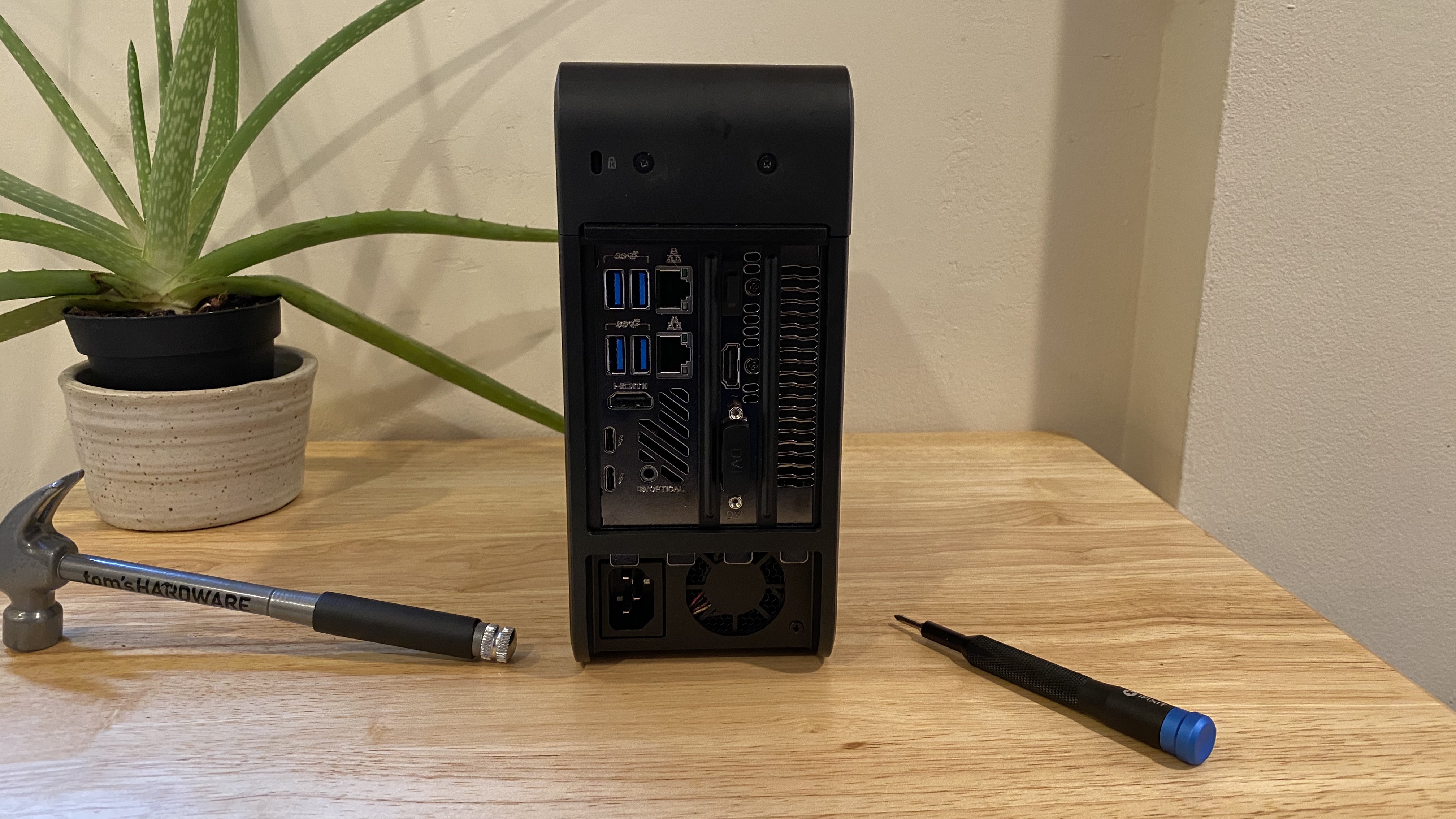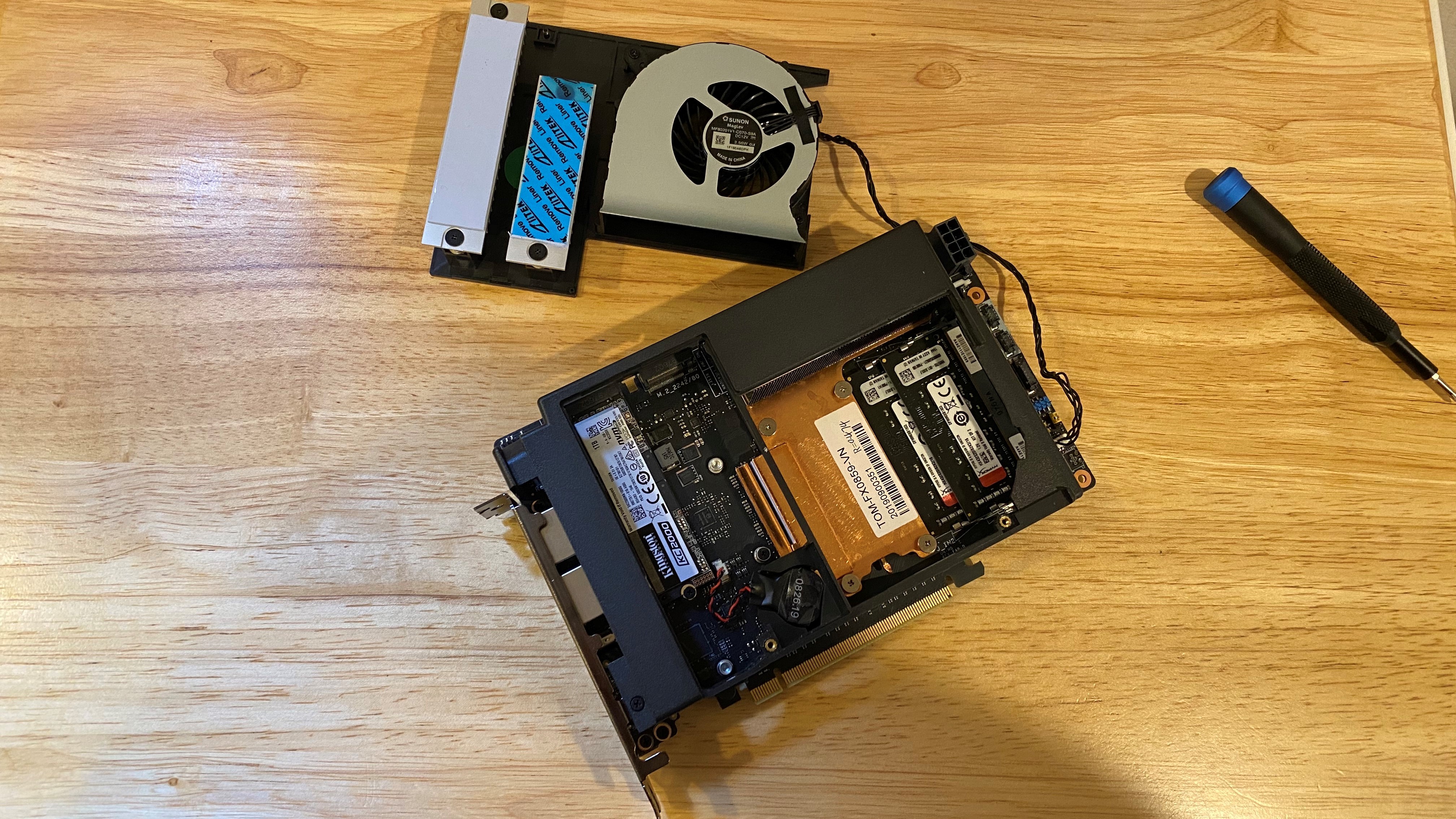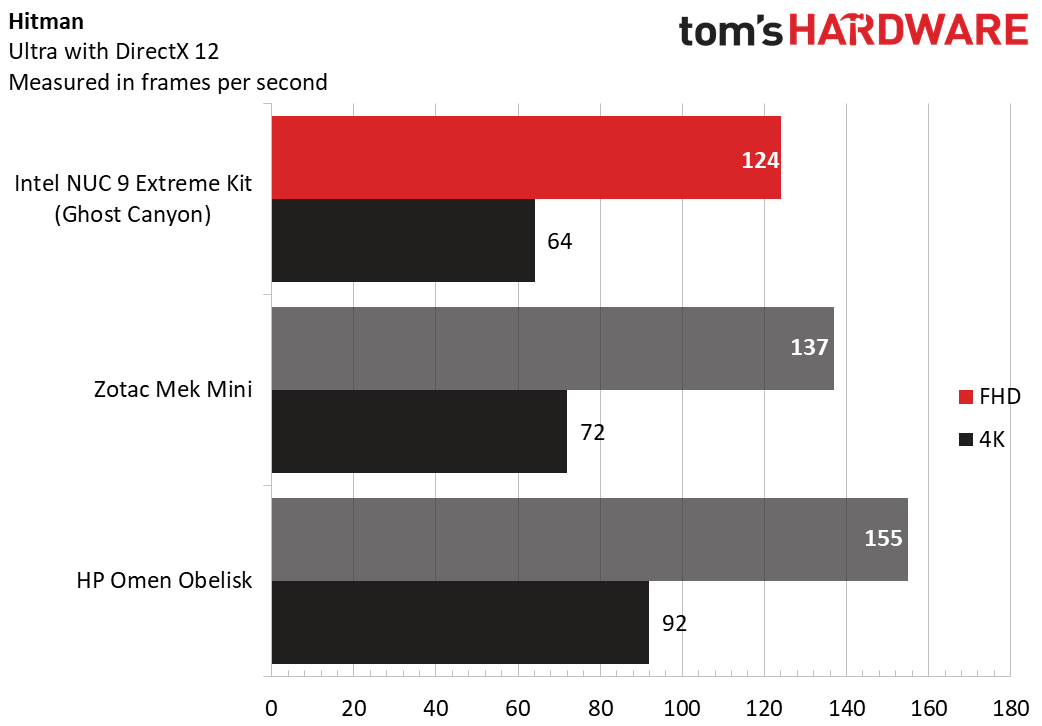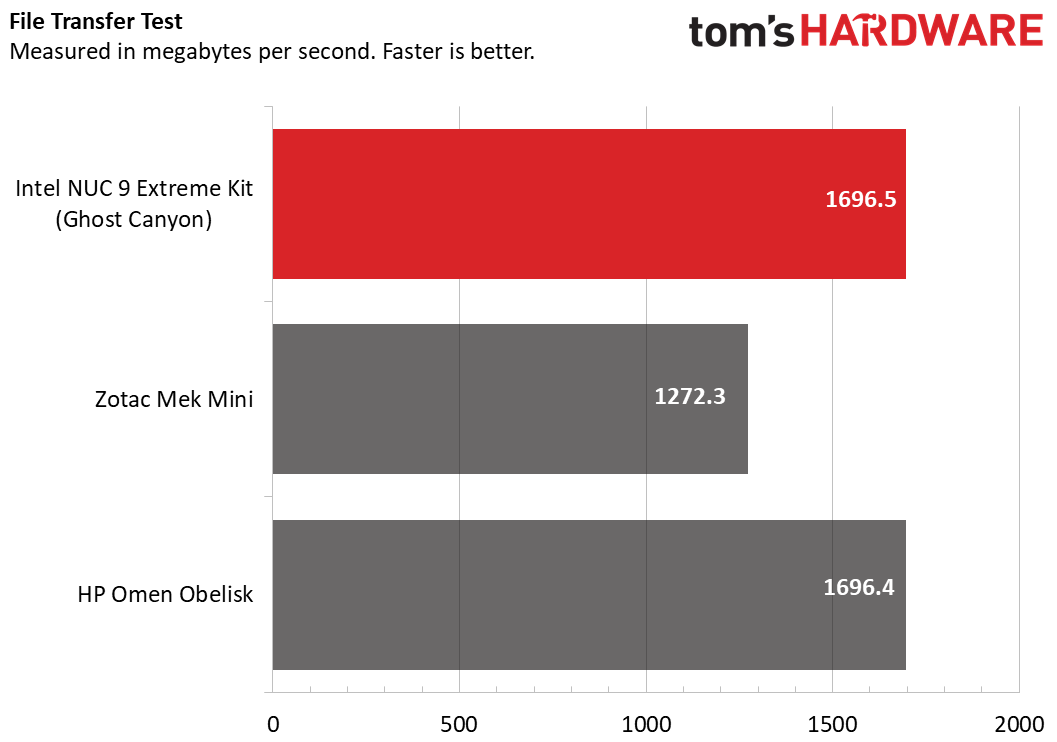Tom's Hardware Verdict
The Intel NUC 9 Extreme Kit (Ghost Canyon) is a pricey barebones PC that fits a discrete GPU. The Compute Element with mobile Intel CPU makes for an exciting new form factor, though.
Pros
- +
Tiny chassis
- +
Fairly easy to upgrade
- +
Strong port selection
- +
Fits discrete GPU
- +
Three-year warranty
Cons
- -
Very expensive
- -
Last-generation CPU
Why you can trust Tom's Hardware
There’s a contingent of the PC community that loves small, space-saving systems. With the NUC 9 Extreme Kit (formerly known as “Ghost Canyon”), Intel has paved the way for a new form factor that can be even smaller than Mini-ITX. It is powered by the Compute Element -- a PCIe-based module with an 9th Gen Intel mobile chip inside. In theory, this paves the way for high-end systems that are smaller than ever before. It’s sold as a barebones kit, so you’ll have to bring your own RAM, SSDs, operating system, and, if you want, a discrete GPU, which pushes the i9 version we reviewed far past its base $1,639.99 price tag.
That makes the NUC 9 Extreme Kit fit for a specific type of person: one who wants their gaming desktop to be as small as possible, and isn’t worried about paying for it. But if it catches on, the Compute Element could become one of the biggest changes to PC building we’ve seen in decades.
Design
For a desktop with an Intel Core i9 and an RTX 2070 (as it shipped to us), the NUC 9 Extreme Kit is tiny. Honestly, it would be adorable if it weren’t adorned by skulls on both sides.
The chassis’ outer edge is made of black plastic, with metal mesh sides. The front panel has a white light ring around the power button, but is otherwise unadorned beyond its ports: an SD-card reader, two USB 2.0 Type-A ports and a 3.5mm headphone jack.



The mesh side panels feature, besides the aforementioned skulls, a honeycomb pattern. Air comes in through the metal mesh and is expelled from the top, which is covered in vents.
On the back are all of the ports attached to the Intel Compute Element, which powers the NUC. There are 4 four USB 3.1 Gen 2 Type-A ports, dual Ethernet, HDMI, a pair of Thunderbolt 3 ports, optical audio and a lock slot. If you have a GPU like our review unit does, the video ports will also be there.
I adore how small this thing is. At just 9.4 x 8.5 x 3.8 inches (238 x 216 x 96mm), it can fit on virtually any desk, as well as in an entertainment center plugged into a TV. Something like this is really perfect while I’m confined to my New York City apartment with a tiny desk. It’s a lot of power for such a small device. The Zotac Mek Mini is slightly larger at 10.3 x 10.2 x 5.4 inches, while one of our favorite prebuilts, the HP Omen Obelisk, is comparatively massive at 17.1 x 14.1 x 6.5 inches.
Specifications
| Intel NUC 9 Extreme Kit (Ghost Canyon) | Additional cost | |
|---|---|---|
| Processor | Intel Core i9-9980HK | ✗ |
| Motherboard | Intel Corporation NUC9i9QNB (U3E1) | ✗ |
| Memory | HyperX Impact 16GB (2x8GB) DDR4-2666 | $113.03 |
| Graphics | Asus Dual GeForce RTX 2070 Mini OC (8GB GDDR6) | $419.99 |
| Storage | Intel Optane 905p 380GB SSD (PCIe NVMe) | $504.66 |
| Kingston KC2000 1TB SSD (PCIe NVMe) | ||
| Networking | Intel Wi-Fi 6 AX200 | ✗ |
| Ports | Front: 2x USB 2.0 Type-A, SD card slot, headphone jack. Back: 4x USB 3.1 Gen 2 Type-A ports, Dual Ethernet ports, HDMI, 2x Thunderbolt 3 ports, Optical audio, Lock slot | ✗ |
| Video Output | DVI, HDMI, DisplayPort | ✗ |
| Power Supply | 500W 80+ Platinum | ✗ |
| Case | Intel NUC 9 Extreme Kit | ✗ |
| Cooling | Dual 80mm exhaust fans | ✗ |
| Operating System | Windows 10 Home | $139.00 |
| Dimensions | 9.4 x 8.5 x 3.8 inches (238 x 216 x 96mm) | ✗ |
| Price As Configured | $1,639.99 | $1,176.68 |
| Total Cost for NUC 9 Extreme Kit and Additional Components | $2,816.67 |
Teardown and Upgradeability
Upgrading the NUC 9 Extreme is unlike doing so on any other desktop. This is the first machine on the market with Intel’s Compute Element, so it’s not a matter of everything simply being plugged into the motherboard. The chassis is small, so it requires some patience, but the only tool you’ll need to get inside is a Phillips-head screwdriver. When you get in there, you see how unorthodox this design truly is.
Get Tom's Hardware's best news and in-depth reviews, straight to your inbox.
To open the NUC, you need to remove two screws from the rear, near the top, which lets you slide off the top. That includes two fans, which are connected by some contacts.


Once those were out, we were able to lift out the side panels. After that, there’s a crossbar, held in by another two screws, on the left side to be removed.
Our unit had an 8-inch Asus Dual GeForce RTX 2070 Mini inside (the dual refers to two fans, not two 2070 GPUs), so that had to be removed. You unplug the power cable from the card, remove two screws that secure the GPU to the case and then lift it out of the PCIe slot on the baseboard. There are two PCIe slots on the board that sit above the power supply (one PCIe x16, one PCIe x4), though the GPU in our unit was a dual-slot card.
With the GPU out of the way, you’re at the Compute Element. If you want to update storage or the RAM, there’s no real reason to lift it out.
The door on the Element is blocked by a paper “air guide,” so you need to hold that back. The door itself is held in place by two screws that need to be removed. Then you can lift the door off, though be careful because a cable attaches to the fan, which is a part of the door.


Inside there are two M.2 slots (one of ours was filled with a Kingston KC2000 1TB SSD). The one on the left fits M.2 modules up to 110 mm in length, while the one on the right can fit a module up to 80 mm.
On the right side of the module are two SODIMM slots. Ours came with a pair of 8GB HyperX Impact RAM (16GB in total). Interestingly enough, it was a 3200 MHz pair, but Intel shipped it running at 2666 MHz.
The kit typically comes empty, so you will need to provide the RAM and storage if you purchase this NUC.
But there’s room for another SSD beneath the Compute Element, so we took that out, too. You remove one screw securing it to the case, and then disconnect the audio, Wi-Fi antenna, USB Type-C, front panel, fans and the 8-pin power connection. The Wi-Fi is particularly easy to remove, with two pins that simply lift out of the Element. Then you can unlock the PCIe slot and lift the Element out.
There’s a heatsink covering the third M.2 slot, which is held down by two screws (this slot can fit modules up to 110mm. When you remove that, you can add more storage. Ours came filled with a 380GB Intel Optane 905p SSD.
At this point, the teardown is essentially complete. The case, Compute Element and GPU are all separated. The pre-installed 500W Flex ATX power supply, however, is still in the case. To get everything back together and working, we had to effectively “build” the PC, reattaching the components and cables.
Gaming and Graphics
The NUC 9 Extreme can fit an 8-inch GPU. In fact, it’s the first of Intel’s NUCs to fit a discrete GPU, period. In the case of our review unit, the graphics card was the Asus Dual GeForce RTX 2070 Mini OC. I took it for a spin by playing Control at 1920 x 1080 with the high settings preset and medium ray tracing preset. The game fell just short of 60 fps, typically hovering between 54 and 59 fps. The exception was on the Astral Plane, a level with an all-white background, in which it went up to 93 fps.
On the Shadow of the Tomb Raider benchmark (highest, 1080p), the game ran at 105 fps on the NUC 9 Extreme, beating both the Mek Mini (RTX 2070 Super) and Omen Obelisk (RTX 2080 Ti). This may be due to updates and patches in between the tests as well as differences in cooling. The NUC dropped 39 fps at 4K.

When it came to Grand Theft Auto V (1080p, very high), The NUC 9 Extreme played the game at 89 fps (27 fps at 4K), falling behind both the Mek Mini and the Omen Obelisk.
On Hitman (1080p, ultra), the NUC ran the game at 124 fps, but still fell behind the Mek and the Omen. It played the game at 64 fps in 4K.
The NUC beat the Mek again in Far Cry New Dawn (1080p, ultra), playing the game at 98 fps to the Mek’s 89 fps. The Obelisk out performed the NUC, at 105 fps. At 4K, though, the Mek Mini eked out a few more frames than the NUC.
To stress test the Ghost Canyon NUC, we ran Metro Exodus 15 times on a loop at the RTX preset. The game ran at an average of 56.3 frames per second and was largely consistent across the 15 runs. It had an average CPU speed of 4 GHz with an average CPU temperature of 74.3 degrees Celsius (165.7 degrees Fahrenheit). The GPU ran at an average clock speed of 1595.1 MHz and an average temperature of 63.8 degrees Celsius (146.8 degrees Fahrenheit).
Productivity Performance
The Intel NUC 9 Extreme Kit (Ghost Canyon) uses a mobile processor. Our Compute Element came equipped with an Intel Core i9-9980HK “Coffee Lake” processor. Our review unit came with 16GB of HyperX Impact RAM, a 380GB Intel Optane PCIe NVMe SSD and a 1TB Kingston KC2000 PCIe NVME SSD. Because this is a barebones kit, performance will vary based on the parts you use.
But this is a desktop, and that’s what we’re comparing it to. Other mini PCs use desktop CPUs, like the Zotac Mek Mini and its Intel Core i7-9700. We’re also comparing it to a desktop i9 in one of our favorite prebuilts, the HP Omen Obelisk (Intel Core i9-9900K).
On Geekbench 4.3, the NUC 9 Extreme earned a score of 30,176, surpassing the Mek Mini (27,156) but losing out to the Omen Obelisk (34,167).
The NUC 9 Extreme took 3 seconds to transfer 4.97GB of files, a rate of 1,696.4 MBps. That’s the same as the Omen Obelisk, but the Zotac Mek Mini was just a tad behind at 1,272.3 MBps.
It took the NUC 9 Extreme 7 minutes and 44 seconds to complete our Handbrake test, which transcodes a 4K video to 1080p. The Omen was faster (5:31), and the Mek Mini fell behind at 8:18.
Software and Warranty
The NUC 9 Extreme Kit doesn’t come with any software. In fact, it doesn’t come with an operating system. While our review unit had Windows 10 Home preinstalled, you’ll need to bring your own if you buy the barebones kit. Fortunately, there are ways to get Windows for Free or Cheap. Intel claims support for Windows 10 and “various” distributions of Linux.
Intel covers the NUC 9 Extreme Kit with a three year warranty.
Is There a Future for This?
Perhaps the biggest question about the Compute Element is whether or not we’ll see them with future processors. Will there be Elements with 10th Gen processors? What about the eventual 11th or 12th Gen? Putting the CPU on an external card could make the CPU in this NUC as upgradeable as the GPU--but only if Intel keeps churning out new Element cards.
As we saw in our teardown, it’s not that difficult to remove the Compute Element from the NUC 9 Extreme Kit. It’s designed to come out. This is a desktop, and many enthusiasts like to upgrade their rigs with new CPUs, as well as RAM, storage, etc.
So the question when spending this much on a barebones rig is if Intel will continue to support the platform. Others are on board for this generation: the Razer Tomahawk and Cyberpower Nox will both have room for full-size graphics cards. HyperX also showed up at CES 2020 with a case that looked very similar to the one on the NUC 9 Extreme.
Intel told Tom’s Hardware in a statement that “we have begun development on the 2021 products and are actively defining the 2022 products. Our goal is to help our partners and customers have an easy drop-in solution to upgrade performance with each refresh cycle.”
It also promised that upcoming NUC Compute Elements will offer backwards compatibility with “carrier boards, meaning customers will not need to redesign boards when upgrading. This may help reduce E-waste, since the whole system will not need to be recycled. Instead, only the Compute Element will be replaced.”
Configurations
The NUC 9 Extreme Kit with Intel Core i9-9980HK costs $1,639.99 at B&H and doesn’t come with RAM, storage, a discrete graphics card or an operating system. Our unit, which came fully kitted out with 16GB of RAM, a 380GB Intel Optane PCIe NVMe SSD, a 1TB PCIe NVME SSD, Asus Dual GeForce RTX 2070 Mini OC GPU and Windows 10 Home, adds up to $2,816.67.
Intel has announced similar barebones Ghost Canyon NUCs with Intel Core i7-9750H and Intel Core i5-9300H processors, but we’re not yet seeing those on sale. Specialist site SimplyNUC is taking pre-orders for each configuration, with 8GB of RAM, a 128GB SSD and “free OS installation,” starting at $1,199 for Core i5 and $1,299 for Core i7. These don’t have discrete GPUs.
Intel told us the i7 and i9 models should ship within the next month, with the i5 model shipping somewhere in the next three months.
Bottom Line
It’s truly impressive how small the Intel NUC 9 Extreme Kit is. The design, with the Compute Element and a built-in mobile processor, is radically different from what one expects from a desktop. To some it may even be, well, extreme.
While we tested the “Ghost Canyon” system with RAM, storage, Windows 10 Home and even a discrete RTX 2070 GPU made specifically for small cases like this. But when this i9-9980HK configuration goes on sale, the barebones kit without any of those things will cost around $1,639.99 (less for the i5 and i7 model). You can get a powerful desktop that’s fully set up for less than that. To turn this into a fully functional gaming PC, you need more than $1,100 in parts. And that’s using a CPU that is already a generation old.
For $60 more than the Ghost Canyon NUC, you could buy the Zotac Mek Mini with a Core i7-9700 and Nvidia GeForce RTX 2070 Super and all of the other parts you need. However, you can’t upgrade the CPU or GPU in that PC (they’re effectively locked in the chassis), so in some ways that’s even less upgradeable. You could also build a nice little Mini-ITX machine for the price, though that will be larger than this.
If size isn't an issue but you want a prebuilt machine, something like the HP Omen Obelisk could be had for cheaper than a fully packed NUC. When maxxed out with a Core i9-9900, 32GB of RAM, an RTX 2070 Super and 7TB of storage, it's almost $2,500 — still cheaper than Ghost Canyon as we reviewed it. But that's also far larger and most of its storage is traditional spinning HDDs.
If you’re a gamer or a creative type with space at a premium, this form factor is sure to excite you. If space is your primary concern and price is no object, this is for you. But you’re also betting on a new platform in the Compute Element. If Intel continues to support it, this could be an enduring new PC form factor, and one that is fairly simple to upgrade or even build.
As it stands, as the first generation of the product, the Intel NUC 9 Extreme Kit makes for a very pricey, space-saving PC with an innovative format that you can customize with parts to your liking. But you have to be willing to pay a premium to be among the first in this PC form factor experiment.

Andrew E. Freedman is a senior editor at Tom's Hardware focusing on laptops, desktops and gaming. He also keeps up with the latest news. A lover of all things gaming and tech, his previous work has shown up in Tom's Guide, Laptop Mag, Kotaku, PCMag and Complex, among others. Follow him on Threads @FreedmanAE and BlueSky @andrewfreedman.net. You can send him tips on Signal: andrewfreedman.01
-
JayNor There are leaks about a NUC 11 box for a couple of Tiger Lake implementations... Panther Canyon and Phantom Canyon.Reply
https://hothardware.com/news/intels-panther-canyon-phantom-canyon-tiger-lake-nucs-leak -
ShattaAD Reply
Isn't Tiger Lake intended to be 28W max? Unless, they release 45W, 8-core parts in late 2020/early 2021 but by then they'll have Rocket Lake and Alder Lake which looks more like the contender in the same TDP class.JayNor said:There are leaks about a NUC 11 box for a couple of Tiger Lake implementations... Panther Canyon and Phantom Canyon.
https://hothardware.com/news/intels-panther-canyon-phantom-canyon-tiger-lake-nucs-leak -
ShattaAD I wonder if AMD will enter into the NUC/CE equivalent market with their super efficient Ryzen 4000 series + PCIe 4.0 support before Intel's own PCIe 4.0 CPUs get released into the wild, just to undercut Intel's market share. Maybe they'll partner with Zotac again to do it knowing Zotac's experience in designing miniature main-boards.Reply -
Gurg The cost of this unit was bloated by:Reply
�
StorageIntel Optane 905p 380GB SSD (PCIe NVMe)$504.66
Kingston KC2000 1TB SSD (PCIe NVMe)
vs: faster Samsung 970 Evo+ 500gb $120 and/or 1gb for $220.
The Hyper X 3200 memory at $114 is overpriced compared to $84 Gskill 3600 Cl16 2x8gb . -
excalibur1814 " far past its base $1,639.99 price tag !"Reply
No. Instant no. It's tempting, but no. There's just too much choice to splash down that amount of cash on something like this. Plus, as we know, will intel release further modules and at what inflated price? -
cyrusfox Reply
You really think the EVO 970 is faster than optane? Maybe in sequential speeds, When is that going to be relevant as both have sequential speeds in excess of 1.5 GB/s? How are you going to feed the storage that much data so that will will actually be a bottleneck?Gurg said:The cost of this unit was bloated by:
�
StorageIntel Optane 905p 380GB SSD (PCIe NVMe)$504.66
Kingston KC2000 1TB SSD (PCIe NVMe)
vs: faster Samsung 970 Evo+ 500gb $120 and/or 1gb for $220.
The Hyper X 3200 memory at $114 is overpriced compared to $84 Gskill 3600 Cl16 2x8gb .
In all the other metrics that matter, Optane is far faster than the Evo 970, Pity the cost per gigabyte is 6x+, here is a link showing the 280GB of optane vs the 970 evo 1TB











